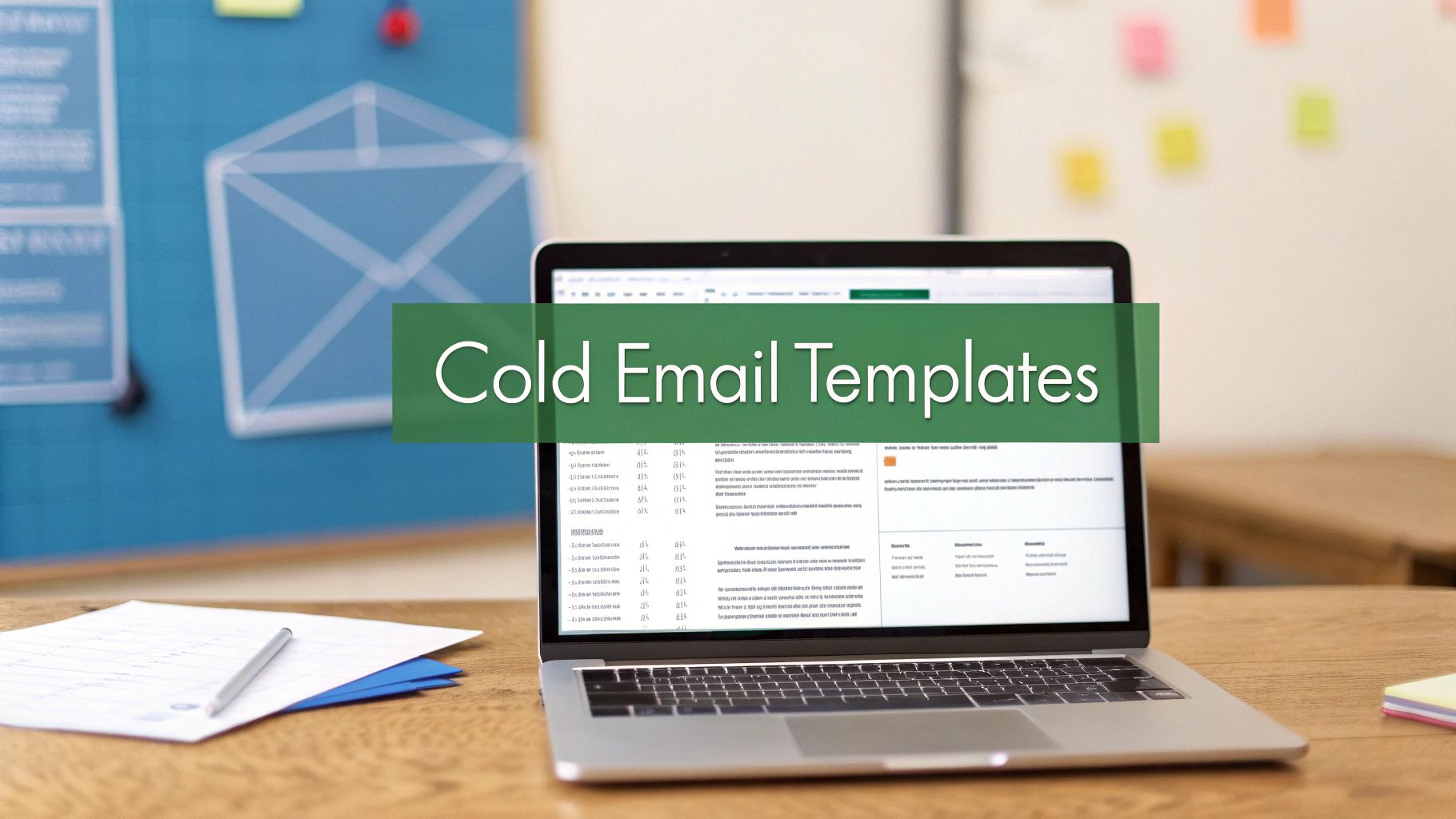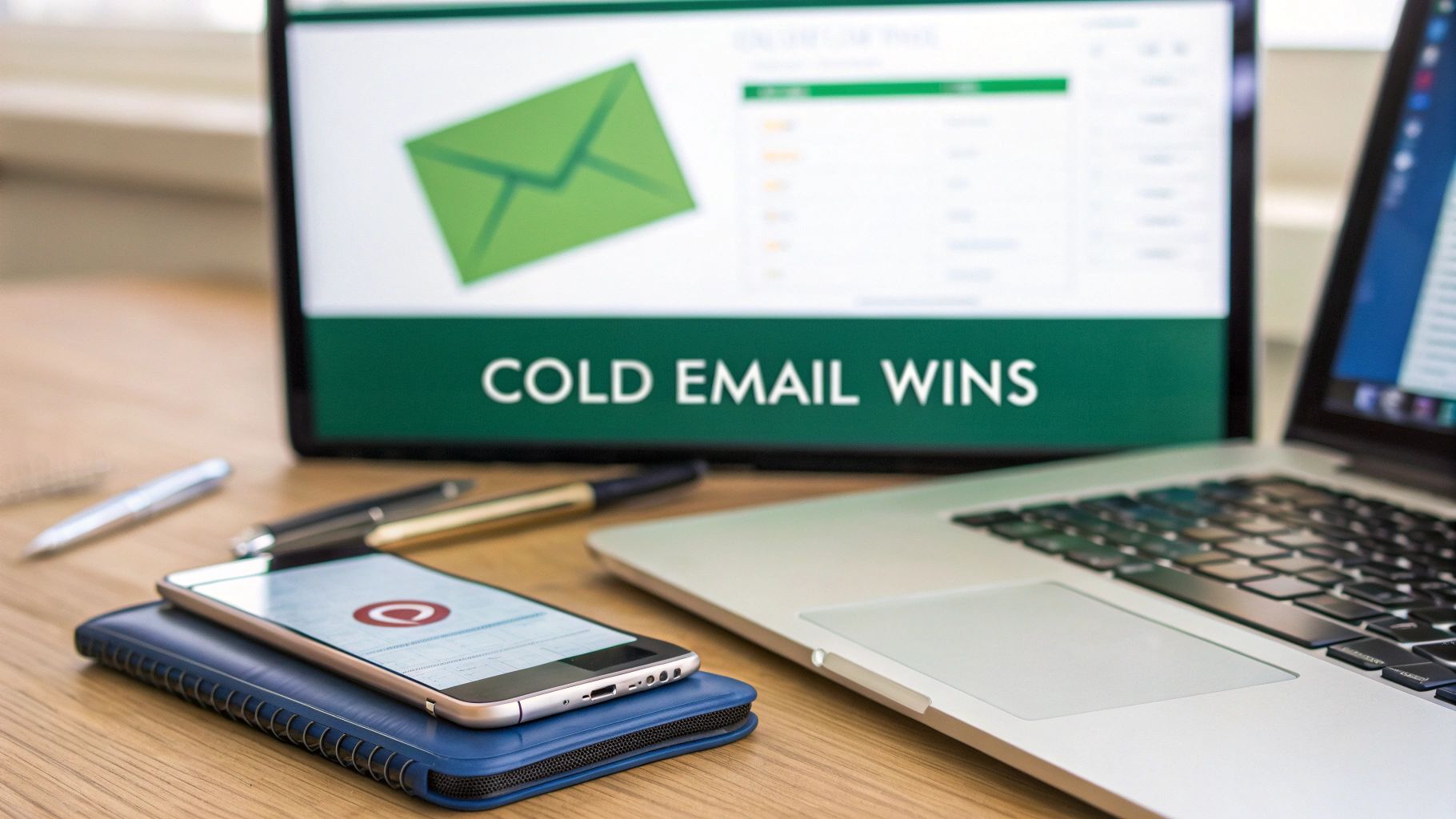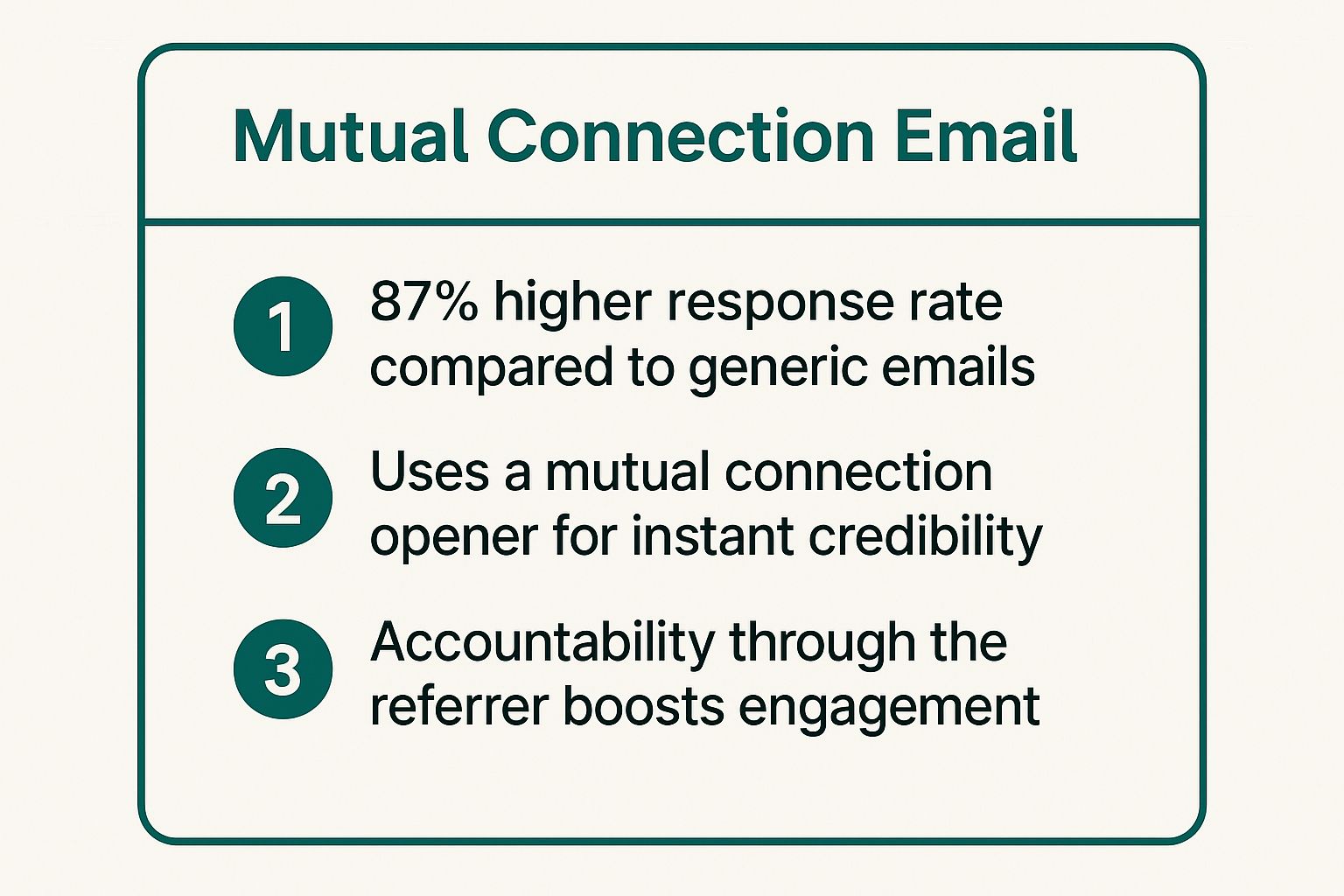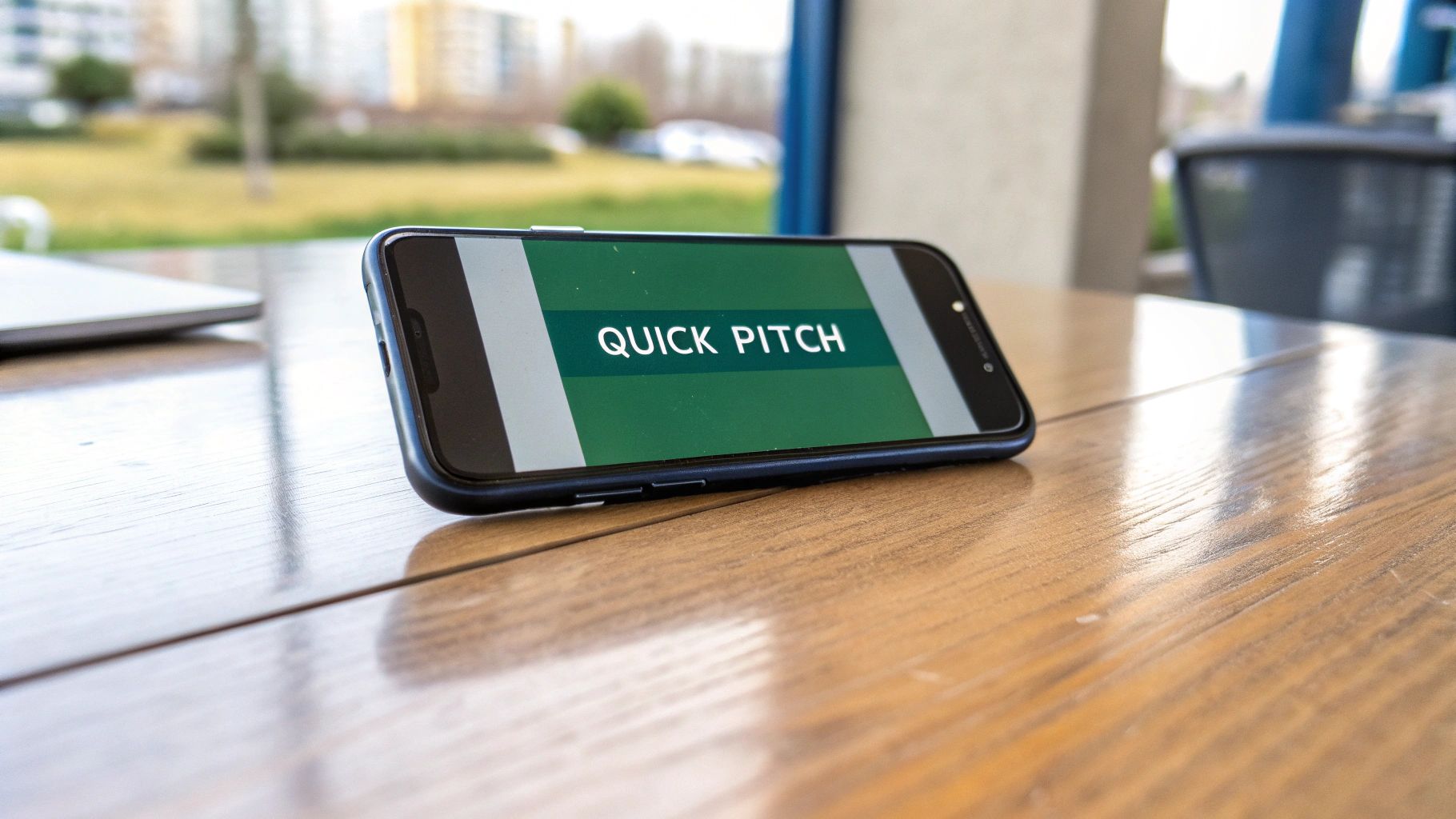Before we even get into how to find email addresses for marketing, we need to talk about why a high-quality list is the most important asset you can build. It's not like social media followers. An email list is a direct line of communication that you completely own, insulating you from the chaos of algorithm changes. Building a list of people who are genuinely interested is the real foundation for long-term, sustainable growth.
Why a Quality Email List Is Your Greatest Asset

Too many marketers get hung up on the size of their email list. The truth is, the real power is in its quality. I'd take a small, engaged list of 1,000 true fans over a bloated list of 100,000 uninterested contacts any day of the week. The goal here is to shift your thinking from just collecting addresses to building a real business asset that gets predictable results.
A good list isn't just a database. It's a direct connection to your most loyal customers and prospects. This is an audience you own, making you immune to the whims of social media platforms where your reach can get cut off overnight. With email, you control the conversation.
The Unmatched ROI of Email Marketing
When it comes to return on investment, nothing really touches email marketing. It’s not just effective; it’s brutally efficient. On average, the ROI for email marketing is estimated at $36 for every $1 spent—a staggering 3,600% return. You can read more insights about this powerful statistic and see why it's a non-negotiable for smart marketers.
This massive financial impact comes down to a few simple things:
- Direct Communication: You can send personalized messages straight to someone's inbox, cutting through the noise of crowded social feeds.
- Audience Ownership: You aren't just renting an audience from a third-party platform. Your list is a tangible asset that only grows more valuable over time.
- High Engagement: These people have literally asked to hear from you, which means they're far more receptive to your content and offers.
From Collection to Connection: A Real-World Example
Let's imagine a small e-commerce brand that sells artisanal coffee. Instead of buying some generic list, they focused on building a quality one by offering a simple discount code to first-time visitors on their site. Over a year, they grew their list to just 2,500 subscribers.
That number might not sound huge, but the list was filled with genuine coffee lovers. When the holiday season rolled around, they launched a targeted campaign for some exclusive gift bundles. The result? That small, dedicated list drove 40% of their total holiday sales.
This scenario proves a critical point: you don't need a massive following to achieve significant results. A well-curated list of people who actually want to hear from you is far more valuable than a vast, indifferent crowd.
This quality-over-quantity mindset is the guiding principle for every ethical strategy we’ll cover. It's all about building relationships, not just filling a database. Each verified, interested contact is a potential long-term customer and brand advocate. This approach transforms email collection from a chore into a core business-building activity. As we get into the specific methods, just remember: the goal is to attract the right people, not just more people.
Alright, let's get down to the real work—sourcing email addresses the right way, without any shortcuts or shady tactics. The best strategies don't involve quick fixes. Instead, they’re built on two solid pillars: drawing in interested people with valuable content and doing respectful, targeted outreach.
Forget about buying email lists. Seriously. It's a dead-end street that wrecks your sender reputation and breaks trust before you even start. A contact you bought has no idea who you are and never asked to hear from you, which is a fast track to getting marked as spam. We're going to build a list of genuinely interested people, one at a time.
Attract Prospects With High-Value Resources
Honestly, the most powerful way to get emails is to have people give them to you. This happens when you offer something so valuable that an email address feels like a fair trade. This is the heart of inbound marketing.
Think about your ideal customer. What keeps them up at night? What information would make their job ridiculously easier? The answer to that is your next "lead magnet"—an irresistible resource they get in exchange for their email.
This doesn't have to be some massive undertaking. Check out these proven ideas:
- A Niche Industry Report: Pull together some original data or break down existing research into a report that offers insights they can't get elsewhere. For a cybersecurity firm, this could be a "State of Small Business Data Breaches" report.
- An Exclusive Webinar: Host a live training session that teaches your audience how to solve one specific, nagging problem. A project management software company could host a webinar on "Running Agile Sprints With a Remote Team."
- A Comprehensive Checklist or Template: Give them a practical tool they can use immediately. A content marketing agency might offer a downloadable "100-Point SEO Audit Checklist."
When you offer real value first, you start the relationship off on the right foot. You’re not just another company selling something; you're a helpful resource, which makes every future email you send that much more effective.
The infographic below gives a great visual breakdown of the key metrics for the ethical email collection methods we're talking about.
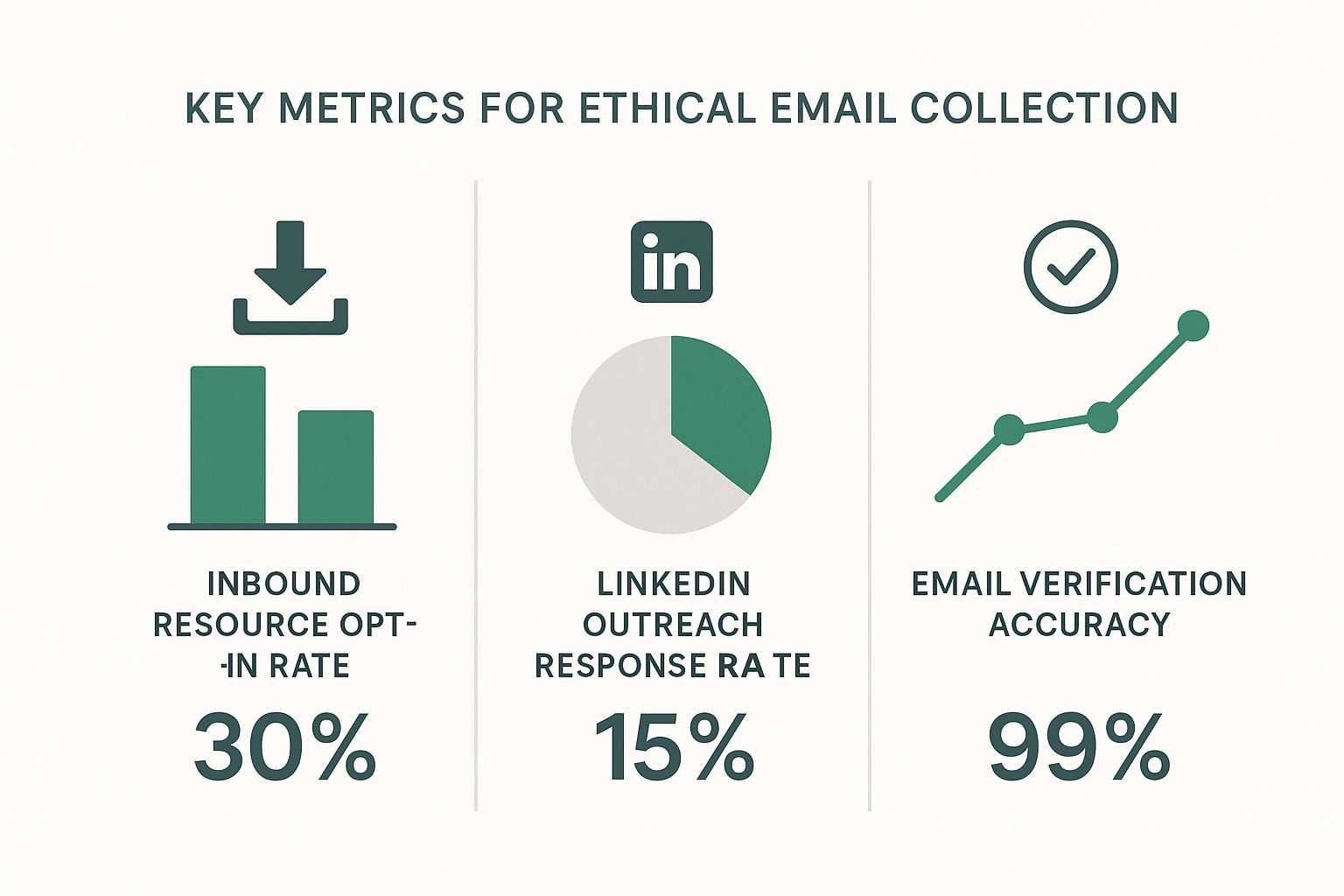
As you can see, while inbound methods naturally pull in higher engagement, combining them with targeted outreach and solid verification creates a really powerful system for building your list.
To give you a clearer picture, here's how different methods stack up against each other.
Comparing Email Acquisition Methods
| Method | Best For | Effort Level | Quality of Leads |
|---|---|---|---|
| Inbound Lead Magnets | Building a warm, engaged audience over time. | Medium to High | High |
| Outbound Prospecting | Targeting specific, high-value accounts and decision-makers. | Medium | Varies (High if targeted well) |
| Networking Events | Making personal connections and gathering direct contacts. | High | Very High |
| Purchasing Lists | (Not Recommended) Quick acquisition, but with major risks. | Low | Very Low |
Ultimately, a balanced approach using a mix of inbound and outbound tactics will give you the most sustainable results.
Pivot to Proactive Outbound Prospecting
While inbound marketing is busy building you a strong foundation, proactive outbound prospecting lets you go after specific accounts and decision-makers with surgical precision. The whole key is to be strategic and respectful, not spammy. For this, there's no better place to start than LinkedIn.
Let's say you're a B2B SaaS company selling an analytics tool for project managers. Your goal is to connect with VPs of Operations at mid-sized tech companies. Instead of blasting out generic connection requests, you need a much sharper approach.
Start by using LinkedIn's search filters to zero in on people who fit your ideal customer profile. You can filter by job title, industry, company size, and location to build a hyper-relevant list of prospects. This initial homework is non-negotiable—it ensures you’re only talking to people who can actually benefit from what you offer.
Once you find a promising prospect on LinkedIn, you hit the next hurdle: finding their professional email address. This is where manual guesswork falls flat and a dedicated tool becomes a lifesaver.
Use Smart Tools for Targeted Email Discovery
Trying to find someone's email by hand is a massive time-sink, and you're often just guessing. A much better way is to use a specialized tool like the EmailScout Chrome extension. It plugs right into your browser, letting you find a verified email address with a single click, directly from a person's LinkedIn profile.
Let's go back to our scenario. You've found a VP of Operations on LinkedIn who looks like a perfect fit. With the EmailScout extension installed, you just go to their profile, click the icon, and it instantly finds and shows their verified corporate email.
This is a total game-changer for outbound sales and marketing. It takes all the friction and guesswork out of the equation, turning a manual scavenger hunt into a smooth, repeatable workflow. You end up spending less time digging and more time connecting.
The process is incredibly simple:
- Identify Prospects: Use LinkedIn Sales Navigator or regular search to build your target list.
- Visit Their Profile: Head over to the individual's LinkedIn page.
- Find the Email: Click the EmailScout extension to instantly uncover their verified email.
- Save and Organize: Add the new contact and their email to your outreach list or CRM.
For anyone who wants to go even deeper, our guide on how to build an email list covers additional strategies and best practices that complement this workflow.
By combining the broad appeal of inbound with the precision of smart outbound prospecting, you create a balanced, powerful system to get email addresses for your marketing. This dual approach keeps your pipeline full with both warm, self-identified leads and hand-picked, high-value prospects, giving your campaigns all the fuel they need to succeed.
Automate Email Discovery with Smart Tools
Let’s be honest: manually searching for email addresses is one of the fastest ways to burn through your day. Digging through websites, sifting through social profiles, and running endless Google searches for a single contact is tedious and just doesn't scale. This is where you learn to work smarter, not harder, by bringing smart automation into your workflow.

Think about a real-world scenario. You just got back from a big industry trade show. It was a huge success, and you have a spreadsheet with the names and companies of 100 promising leads. The old-school approach would mean blocking off the next few days for a mind-numbing scavenger hunt online.
But instead of facing that manual grind, you can turn a multi-day project into a task that takes just a few minutes. This is exactly how you get email addresses for marketing at scale without sacrificing quality.
From Manual Grind to Automated Enrichment
The modern approach is to use a bulk email finder, a tool designed for this exact challenge. With a service like EmailScout, you can take that raw list of prospects and automatically enrich it with verified, accurate contact information.
The process is refreshingly simple. Just format your spreadsheet into a CSV file with columns for the first name, last name, and company domain. Then, upload it directly into the tool’s Bulk Finder feature.
In a matter of minutes, the system gets to work on your entire list. It systematically searches for and pins down the correct email addresses for each person, turning your basic spreadsheet into a powerful outreach list, ready to go.
Understanding Confidence Scores for Smarter Outreach
Once the tool processes your list, it doesn't just dump a bunch of emails on you. A critical feature you'll notice is a confidence score next to each result. This little number is a game-changer for prioritizing your outreach.
Here’s a quick breakdown of what these scores usually mean:
- High Confidence (e.g., 90-99%): The tool is almost certain this is the correct, deliverable email. These are your top-tier contacts to hit up first.
- Medium Confidence (e.g., 60-89%): There's a solid chance this email is correct, but it might be a catch-all address or based on a common pattern that couldn't be 100% verified.
- Low Confidence (e.g., below 60%): These are educated guesses. Approach these with caution to avoid hurting your sender reputation with a high bounce rate.
By paying attention to these scores, you can segment your outreach intelligently. Kick off your campaign with the high-confidence contacts to get the best initial engagement and deliverability. For the lower-scoring ones, you might decide a little extra manual research is worth it before you hit send.
This strategic prioritization is what separates efficient marketers from busy ones. Instead of treating every contact the same, you're using data to focus your energy where it will have the biggest impact, ensuring your first wave of emails reaches the right inboxes.
Integrating Tools into a Seamless Workflow
The real magic happens when you integrate these tools into your larger sales and marketing process. Finding the emails is just one piece of the puzzle. The next step is getting rid of the friction caused by manual data entry.
Modern email finders like EmailScout are built to connect with the platforms you already use. This means you can often send the enriched data straight to your Customer Relationship Management (CRM) or email marketing platform.
This creates a seamless lead generation machine:
- Acquire Leads: Gather company names and decision-makers from events, LinkedIn, or other sources.
- Enrich Data: Use a bulk finder to automatically discover verified email addresses.
- Sync Contacts: Push the enriched, high-confidence contacts directly into your CRM.
- Launch Campaigns: Immediately enroll these new contacts into your targeted outreach sequences.
This closed-loop system pretty much eliminates the risk of human error from copy-pasting data and dramatically shrinks the time from lead identification to first contact. You're not just finding emails faster; you're acting on them faster, too. For a detailed comparison of different options, our guide on the best email finder tools offers a comprehensive look at the top solutions available.
Ultimately, automating email discovery is about building a system that can grow with you. It frees you from the repetitive tasks, so you can focus on crafting compelling messages and building relationships—the work that truly drives results.
Verify Emails to Protect Your Sender Reputation
Sending an email campaign to a list you haven't cleaned is a massive gamble. Think of it like shipping expensive products without double-checking the delivery addresses first—it's wasteful, costly, and ultimately damages your brand's reputation with postal services.
In the email world, those "postal services" are Internet Service Providers (ISPs) like Gmail and Outlook.
When you fire off emails to invalid or dead addresses, they bounce back. A high bounce rate is one of the biggest red flags for ISPs. It signals that you might be a spammer using sloppy list-building habits, which can absolutely tank your sender reputation and future deliverability.
The Anatomy of Email Verification
So what’s actually going on when you verify an email address? It’s not just a quick check to see if the format looks right. A proper verification process is a sequence of technical checks running behind the scenes to confirm an inbox is real, active, and ready to receive mail.
A solid verification tool will run through a few key steps:
- Syntax Check: This is the first, most basic pass. It just makes sure the email follows the standard
name@example.comformat and doesn't have any weird characters or obvious typos. - Domain Validation: Next, the tool checks if the domain (
example.com) is even real and has active mail servers set up to receive email. No point in going further if the domain itself is a dud. - SMTP Ping: This is where the magic happens. The system basically starts a "handshake" with the recipient's mail server without actually sending an email. This "ping" confirms whether that specific user account actually exists on that server.
This multi-layered process is what separates a clean, effective list from one that’s going to get your domain flagged.
A Practical Walkthrough with an Email Verifier
Let’s make this real. Say you have a list of 500 contacts you pulled together from a networking event and some LinkedIn prospecting. Before you even dream of loading them into your campaign software, you need to run them through a verifier.
Using a tool like EmailScout's verifier makes this painless. You just upload your list, usually as a CSV file. The platform then churns through each contact, running all the checks we just talked about.
The output you get back isn't just a simple "valid" or "invalid" stamp. You get much richer feedback, like "deliverable," "risky" (maybe it's a catch-all server), or "undeliverable." This is the kind of detail that lets you make smart decisions instead of just guessing.
If you really want to get into the weeds on this, our complete guide on email address verification breaks down every single step and why it matters for your campaigns.
The Real-World Impact of Verification
Cleaning your list isn't just some technical busywork; it has a direct, measurable impact on how your campaigns perform.
I know of a B2B software startup that was getting killed on their cold outreach. Their initial campaigns had a painful bounce rate of around 12%, and their open rates were limping along below 20%. It was a mess.
Frustrated, they made one simple change: they made pre-send verification mandatory for every list. No exceptions. They started running every batch of new contacts through a verifier before hitting send.
The results were almost immediate:
- Bounce Rate Plummeted: Their bounce rate dropped from a scary 12% to less than 1% on their very next campaign.
- Open Rates Soared: With their sender reputation on the mend, their open rates jumped by 15% in just two months.
- Engagement Spiked: Because their emails were actually landing in real inboxes, they saw a huge lift in replies and demo requests.
That small shift in their process turned their email outreach from a frustrating waste of time into a predictable way to get leads. Making pre-send verification a non-negotiable step is one of the most powerful things you can do to protect your most valuable digital asset: your sender reputation.
Organize and Segment Contacts for High Impact Campaigns

Getting a list of fresh emails is a great start, but it's just raw potential. The real power comes from organizing that list. If you just blast the same generic message to everyone, you’re setting yourself up for low open rates and a flood of unsubscribes.
The secret to making your marketing actually work is segmentation. It’s a simple concept: you slice your main email list into smaller, more focused groups based on what you know about them. This lets you stop sending one-size-fits-all emails and start delivering personalized content that actually connects with each group. It’s how you turn a list of names into a real source of revenue.
Moving Beyond Basic Segmentation
Good segmentation is way more than just sorting by location. To create campaigns that really land, you have to group your contacts by data that reflects who they are professionally, what they care about, and how they found you in the first place. The more detail you have, the more personal you can get.
Here are a few powerful ways I like to segment contact lists:
- By Job Title: You wouldn't talk to a CEO the same way you'd talk to a Marketing Manager. Grouping by title lets you adjust your tone and focus on the specific problems and goals that matter to their role.
- By Industry: A software company selling to both healthcare and finance needs completely different messaging for each. When you segment by industry, you can use case studies, jargon, and examples that resonate with them.
- By Company Size: A 10-person startup has wildly different needs than a 1,000-employee corporation. This simple filter helps you frame your offer as the perfect solution for their scale.
- By Lead Source: Think about where you got the contact. Someone who signed up for your webinar is a much warmer lead than a cold prospect from LinkedIn. Tagging them by source helps you decide how direct or gentle your follow-up should be.
For example, a digital marketing agency could create a segment of contacts from e-commerce companies. To that group, they might send a case study on boosting online sales with SEO. At the same time, they could send a completely different offer about local lead generation to another segment of brick-and-mortar businesses.
Prioritizing List Hygiene and Compliance
As you organize your list, you absolutely have to keep it clean and legal. This isn't optional.
List hygiene is just the process of regularly clearing out dead-weight—inactive subscribers and bad email addresses. Cleaning your list keeps your bounce rate low, which protects your sender reputation and makes sure your emails actually get delivered.
Equally important is playing by the rules. Following email marketing laws isn't just about avoiding hefty fines; it’s about building trust with your audience.
Key Compliance Checkpoints
- CAN-SPAM Act (U.S.): This law means you must include your physical address in every email, have a clear unsubscribe link, and honor opt-out requests immediately.
- GDPR (EU): If you have contacts in the European Union, the General Data Protection Regulation demands you get clear, explicit consent before sending them marketing emails. You also need to be able to prove they opted in.
Make these practices part of your workflow from day one. An organized, clean, and compliant list is the bedrock of every successful email campaign you’ll ever run.
Common Questions About Finding Email Addresses
As you start pulling together email lists for your marketing campaigns, you're bound to run into a few tricky questions. Figuring out the legal and strategic details is key to building an outreach process that actually works without getting you blacklisted.
Let's clear up some of the most common concerns right now.
Is It Legal to Email People I Find Online?
This is the big one, and the short answer is: it depends. The crucial factor is who you're emailing—another business (B2B) or a regular consumer (B2C).
For B2B outreach, regulations like the CAN-SPAM Act in the U.S. often operate under the idea of “legitimate interest.” In simple terms, this means you can generally email a business contact if your product or service is truly relevant to what they do for a living.
But this isn't a free-for-all. Your outreach still has to play by some non-negotiable rules:
- Offer Real Value: Don't just send a lazy sales pitch. Your message needs to offer a genuine solution or a useful insight.
- Be Upfront: Make it crystal clear who you are and what your company does. No mystery games.
- Provide a Clear Opt-Out: Every single email must have an obvious, one-click way for them to say "no thanks" and unsubscribe.
How Many Follow-Up Emails Are Too Many?
This is where a lot of people go wrong. Bombarding someone with follow-ups is the fastest way to get your emails sent straight to the spam folder.
A good rule of thumb for cold outreach is a sequence of 3-4 emails spaced out over a few weeks. Anything beyond that usually just annoys people and can start to tarnish your brand's reputation.
The real secret is making every follow-up different. Instead of just saying "Hey, just checking in," bring something new to the table each time—a relevant case study, a helpful article, or a new idea they hadn't considered.
What Is a Realistic Bounce Rate for a Cold Campaign?
When you're running a cold campaign with a list you've sourced and verified yourself, you should aim for a bounce rate under 5%. This is a healthy target that tells you your list quality is solid.
If you see your bounce rate climbing over 5%, that's a red flag. It’s a loud-and-clear signal that something is wrong with your list's accuracy or your verification process is broken. You need to fix it immediately to protect your sender reputation.
Ready to build a high-quality, verified email list the smart way? EmailScout gives you the tools to find, verify, and organize contacts for your marketing campaigns, all with a single click. Start finding unlimited emails for free at https://emailscout.io.

